If you’re living with osteoporosis, you’ll want to choose exercise equipment that builds bone density while minimizing fracture risk. Safe options include treadmills and elliptical machines for weight-bearing cardio, strength training machines like lat pulldowns and leg presses for controlled resistance, and home equipment such as light dumbbells, resistance bands, and stability balls. Avoid high-impact machines and equipment requiring rapid movements. Following these guidelines guarantees you’ll discover effective ways to maintain bone health safely.
Understanding Osteoporosis and Exercise Safety Requirements
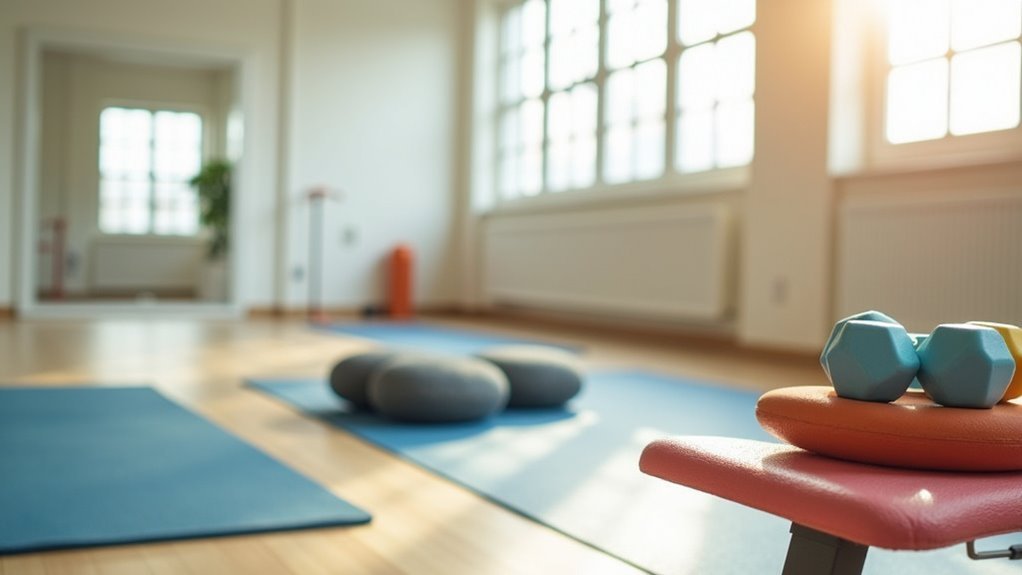
When you’re living with osteoporosis, your bones become fragile and prone to fractures, making exercise selection a critical safety concern rather than just a fitness preference. Your bones have lost density and strength, particularly affecting your hip, spine, and wrist areas where fractures commonly occur.
With osteoporosis, exercise becomes a delicate balance between maintaining bone health and preventing dangerous fractures through careful movement choices.
You’ll need to prioritize exercise safety by choosing appropriate equipment and maintaining proper form throughout your workouts. Weight-bearing exercise and strength training remain essential for improving your bone health, but you must approach them carefully to minimize fracture risk.
Low-impact exercises using stable equipment can provide the bone-stimulating benefits you need without dangerous stress.
Before starting any regimen, consult your healthcare provider to establish safe parameters for your specific condition and current bone density levels.
Weight-Bearing Cardiovascular Equipment for Bone Health
Weight-bearing cardiovascular equipment offers you the perfect combination of bone stimulation and heart health benefits while maintaining the safety standards your condition requires.
Treadmills and elliptical machines provide excellent weight-bearing exercise options that promote bone density while delivering low-impact workouts. These machines help osteoporosis patients build bone strength through controlled movements that prevent falls and reduce injury risk.
Treadmills allow you to walk or jog at your own pace, effectively targeting hip and spine areas where fractures commonly occur.
Elliptical machines engage your entire body through smooth, joint-friendly motion that won’t stress your bones excessively.
Start with 10-20 minutes daily and gradually increase to 30 minutes as your fitness improves, maximizing both cardiovascular health and bone formation benefits.
Strength Training Machines for Upper Body Development
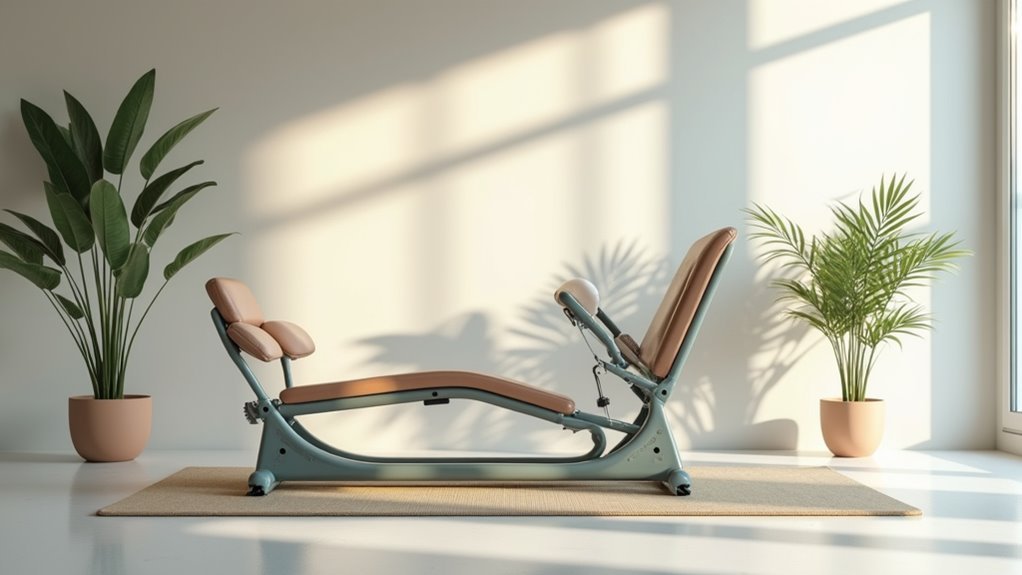
Since upper body strength directly impacts your spinal stability and posture, strength training machines become invaluable tools for managing osteoporosis safely and effectively.
These machines offer controlled movements with adjustable weights, making them ideal for osteoporosis patients who need safer exercise alternatives.
Strength training machines provide the controlled, adjustable resistance that osteoporosis patients need for safe and effective exercise progression.
The lat pulldown strengthens your back muscles while supporting proper spinal alignment.
Remember to maintain proper form by pulling the bar to your chest, never behind your neck, to avoid unnecessary strain.
The seated row machine targets your upper back and shoulders, helping correct slouched posture common in osteoporosis patients.
These strength training machines allow you to build muscle mass progressively, which supports bone health and helps reduce fracture risk through enhanced upper body strength and improved postural support.
Lower Body Strength Equipment and Proper Techniques
You’ll find the leg press machine particularly valuable for building lower body strength while protecting your bones from excessive impact.
This equipment allows you to work your quadriceps, hamstrings, and glutes with controlled resistance that’s safer than free weights or high-impact exercises.
Mastering proper form on the leg press becomes essential for maximizing benefits while minimizing your risk of injury or fracture.
Leg Press Machine Benefits
One of the most valuable pieces of equipment for osteoporosis patients is the leg press machine, which builds lower body strength while minimizing stress on your knees and ankles.
This safe exercise equipment promotes proper alignment and controlled motion, essential for injury prevention during strength training. You’ll want to avoid full leg extension to reduce knee strain and start with manageable weight to maintain comfort and form.
Perform 3 sets of 10-12 repetitions to enhance muscle strength and support bone density in your lower body.
Consider incorporating single-leg presses using less than half your two-leg weight. This variation further reduces strain while improving balance, making it particularly beneficial for osteoporosis patients seeking thorough lower body development with maximum safety.
Proper Form Techniques
Mastering proper form while using leg press machines requires attention to several key positioning elements that protect your joints and maximize muscle engagement. You’ll need to position your feet hip-width apart on the platform, maintaining a neutral spine throughout each repetition. Avoid full leg extension to reduce injury risk while performing these lower body strength exercises.
| Form Element | Correct Technique | Safety Benefit |
|---|---|---|
| Foot Placement | Hip-width apart positioning | Ideal muscle activation |
| Spine Position | Maintain neutral alignment | Prevents spinal compression |
| Range of Motion | Stop before full extension | Reduces joint stress |
Regularly adjust your customized equipment settings for proper body mechanics. These safe exercise protocols make leg press machines excellent osteoporosis exercises when combined with posture exercises targeting your upper back for thorough strength training.
Essential Home Gym Equipment for Osteoporosis Management
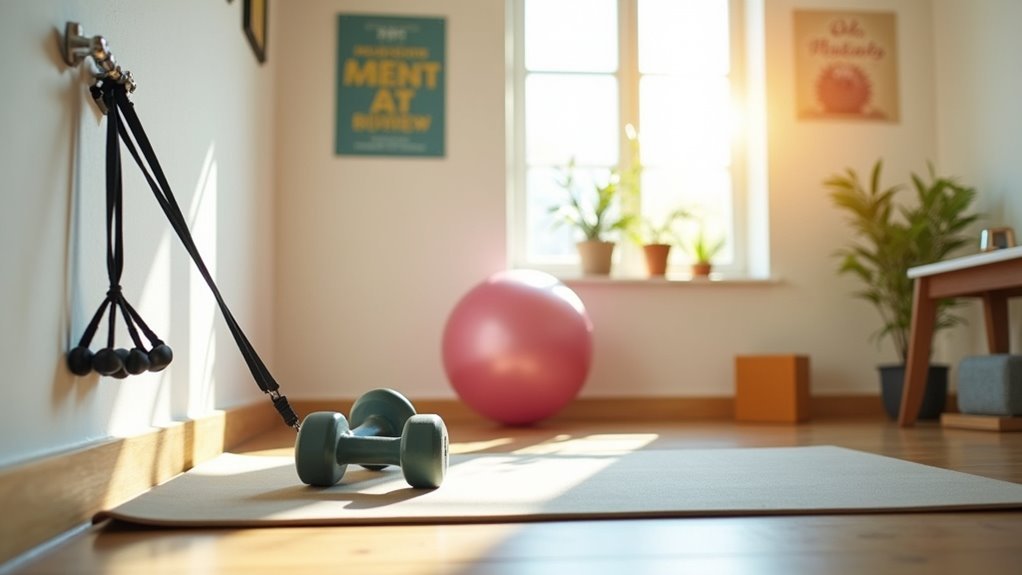
You’ll need specific equipment that prioritizes safety while effectively targeting bone health through controlled resistance training.
Core stability equipment like burst-resistant stability balls will help you build the foundation strength essential for balance and fracture prevention.
Resistance training tools, including adjustable dumbbells and elastic bands, provide the progressive loading your bones need without excessive joint stress.
Core Stability Equipment
When managing osteoporosis at home, core stability equipment serves as your foundation for building strength while protecting vulnerable bones.
Stability balls offer exceptional value for low-impact strengthening while improving balance and reducing fall risk. You’ll strengthen muscles supporting spine support, enhancing posture and functional mobility essential for daily activities.
Top Core Stability Equipment Benefits:
- Enhanced Balance Training – Stability balls challenge your core muscles through unstable surfaces, improving coordination and reducing fall risk through progressive muscle engagement.
- Spine-Safe Exercises – Perform seated marches and wall squats that promote proper alignment while strengthening core muscles without high-impact stress on vulnerable bones.
- Improved Functional Mobility – Regular core stability training maintains movement patterns needed for daily tasks while supporting overall bone health through consistent muscle engagement and postural improvements.
Resistance Training Tools
Building upon your core stability foundation, resistance training tools amplify your bone-strengthening efforts through targeted muscle development that directly benefits bone density.
Dumbbells and resistance bands are essential equipment for osteoporosis management, effectively building muscle strength while reducing fracture risk. You’ll find ankle weights particularly useful for lower body exercises, strengthening leg muscles and improving stability.
Loop bands and TheraBands offer versatile, lightweight options for low-impact exercises that adapt to your fitness level. However, maintaining proper form is vital to maximize bone-building benefits and prevent injury.
Consult a healthcare professional for guidance when starting your fitness routine. Incorporating varied resistance training exercises not only maintains bone health but also improves muscle tone and balance.
Free Weights and Resistance Training Safety Guidelines
Although free weights like dumbbells and kettlebells offer excellent resistance training benefits for osteoporosis patients, they demand careful attention to proper form and safety guidelines.
Proper handling techniques are essential for fall prevention and injury reduction.
When starting resistance training with free weights, you’ll want to follow these critical safety protocols:
- Begin with light weights (5-20 pounds) and gradually increase resistance as your strength improves while maintaining proper body mechanics.
- Perform exercises like bicep curls standing rather than seated to enhance stability and reduce spinal strain.
- Use non-slip mats during workouts to prevent slips and maintain secure footing.
Regular consultation with a physical therapist guarantees your resistance training routine remains safe and effective as you progress through different exercises.
Flexibility and Recovery Equipment Options
Several specialized tools can greatly enhance your flexibility routine and accelerate recovery while protecting your bone health. These safe exercise equipment options help reduce injury risk while building essential core stability for osteoporosis management.
| Equipment | Primary Benefits | Safety Features |
|---|---|---|
| Foam Rollers | Self-myofascial release, muscle soreness relief | Low-impact pressure application |
| Yoga Mats | Non-slip surface for stretching exercises | Fall prevention, joint cushioning |
| Resistance Bands | Improved range of motion without bone strain | Gentle, controlled resistance |
| Balance Boards | Enhanced balance and core stability | Progressive difficulty adjustment |
Massage guns promote muscle recovery by increasing blood flow, while resistance bands offer controlled stretching exercises that won’t stress fragile bones. You’ll find these tools particularly effective for maintaining flexibility and preventing the muscle stiffness common with osteoporosis.
Equipment Selection Criteria and Budget Considerations
When choosing exercise equipment for osteoporosis management, you’ll need to evaluate several key factors that directly impact both safety and long-term success. Your investment in high-quality machines and durable machines will minimize injury risks while providing effective for building bone strength benefits.
Consider these essential selection criteria:
- Safety and Comfort Standards – Prioritize equipment that meets rigorous safety standards and offers comfortable positioning for safe workouts, especially if you’ll exercise alone.
- Space and Budget Planning – Assess your space availability carefully and establish realistic budget considerations that balance cost with quality requirements.
- Research and Reviews – Read thorough product reviews and expert recommendations to identify exercise equipment for osteoporosis that delivers proven results within your price range.
Exercises and Equipment to Avoid With Osteoporosis
Understanding which exercises to avoid becomes just as essential as selecting safe equipment when you’re managing osteoporosis.
You’ll need to avoid high-impact exercises like running and jumping, which stress weakened bones and increase falls and fractures risk.
Exercise machines that encourage bending forward motions, such as traditional sit-up benches, can cause compression fractures in your spine.
Avoid equipment promoting twisting movements, like rotational ab machines commonly used in golf training.
Rapid jerky movements from certain machines pose significant dangers for osteoporosis patients.
Skip trampolines, high-impact aerobic equipment, and any apparatus requiring sudden directional changes.
Always consult a healthcare provider before using new exercise equipment to verify it’s appropriate for your specific condition and bone density levels.
Frequently Asked Questions
What Exercise Equipment Is Best for Osteoporosis?
You’ll benefit most from weight-bearing equipment like treadmills and ellipticals, strength training machines including lat pulldowns, and resistance bands. They’ll build bone density while protecting your joints when you maintain proper form.
What Is the Safest Exercise for Osteoporosis?
Walking’s the safest exercise you can do for osteoporosis. It’s low-impact, weight-bearing, and builds bone density without stressing your joints. Start slowly and gradually increase your pace and duration as you get stronger.
Which Is Better for Osteoporosis, a Treadmill or an Elliptical?
You’ll find treadmills better for osteoporosis since they’re weight-bearing exercises that build bone density in your hips and spine. However, if you’ve got joint issues, ellipticals offer safer low-impact alternatives.
Which Exercise Is the Best Choice for Someone With Osteoporosis to Safely Perform on the Chair?
You’ll find seated leg lifts are your best choice for safely exercising with osteoporosis. They’ll strengthen your hip flexors and quadriceps while you’re seated, minimizing fall risks and bone strain.
In Summary
You’ll find that investing in the right exercise equipment can greatly improve your bone health while keeping you safe. Choose weight-bearing machines, resistance bands, and stability equipment that support proper form. Avoid high-impact or twisting movements that could increase fracture risk. Start slowly, focus on progressive resistance training, and always consult your healthcare provider before beginning any new exercise program. Your bones will thank you for making smart equipment choices.

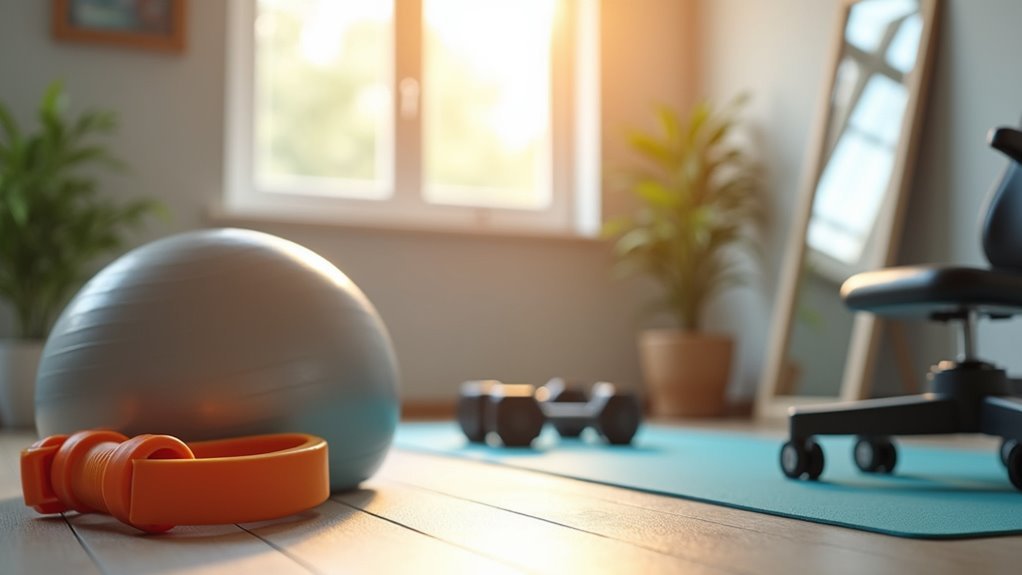
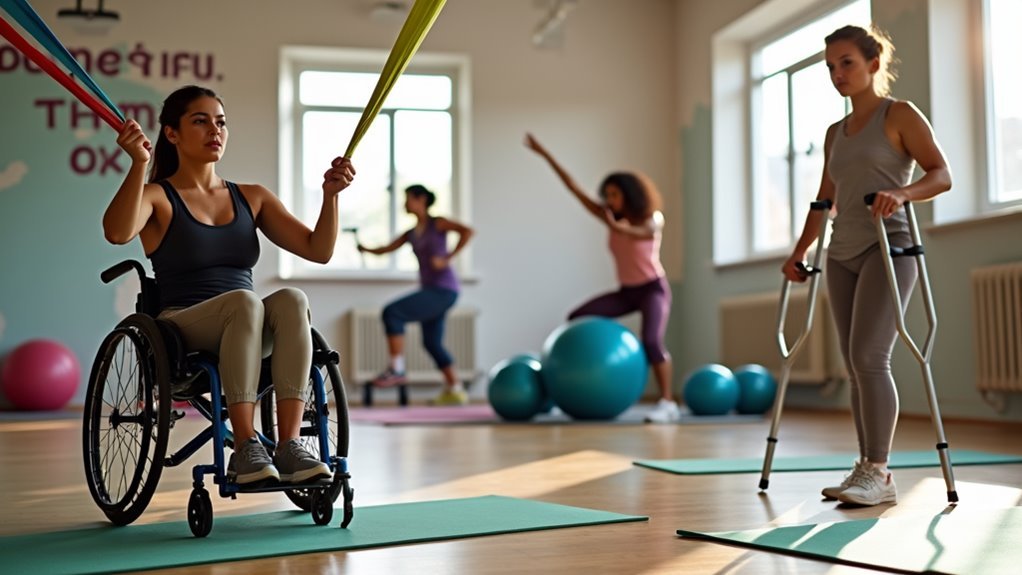
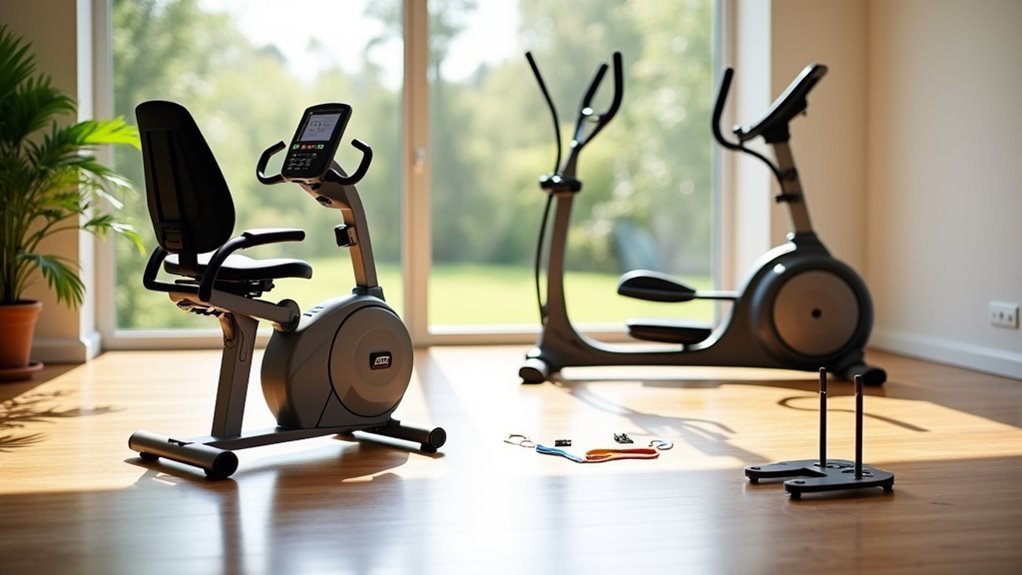
Leave a Reply